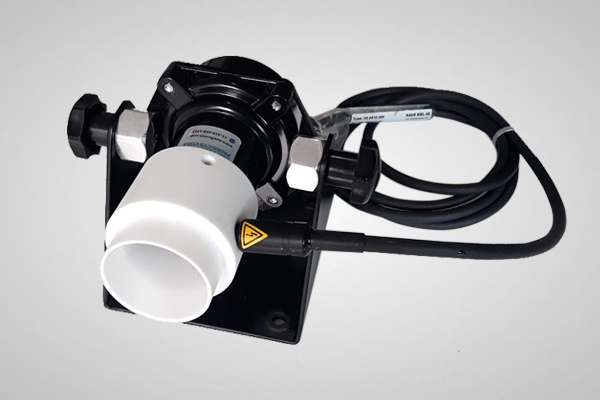WHY USE AIR AMPLIFICATION PRODUCTS WITH STATIC CONTROL?
Static control involves the use of static elimination devices (ionizers) to eliminate the static charge on a charged surface. There are several different types of static elimination systems but the ones used most often in industry, and used with Nex Flow® air amplification products are AC ionizers.
What happens with an AC ionizer is that on every AC current cycle the air around the ionizer is “ionized” – first with a negative charge and then a positive charge. So you create an ion cloud of positive and negative ions. With these types of static elimination bars, you generally have to be quite close to the bar to eliminate the static on the charged surface. If the surface charge is negative, the positive ions eliminate the negative charge and if the surface charge is positive, the negative ions neutralize the charge. The other ions are repelled back into the atmosphere.
Ionizers are used on their own extensively in the industry but most of the applications through Nex Flow® are in combination with either an air knife or air amplifier for cleaning and/or for static removal at a distance. Nex Flow® only utilizes static bars that are well made and have power supplies with adequate voltage for long life. Here is what to look for in a static elimination system:
- Strong static bars and “pins” – when choosing an ionizer the static bar should be rugged enough for a factory environment. There is an entire technology based on static “pin” design as the pins produce the “ions”. If the pin is easily bent or damaged, it signals a possible short ionizer life (and cost).
- 7 KV or higher Power Supply – all ionizers require a high voltage power supply to operate. It has been well documented for some time that a power supply 7 KV or higher is better than lower voltage units (commonly 5 KV) because they simply last longer. The connection between the power supply to the ionizer is a high voltage cable and power is lost in the cable. In addition, the power supply transformer will weaken over time. A 7 KV power supply will last longer, and that means lower replacement cost.
- Repairable Power Supply – this is a very important feature and many power supplies are NOT repairable. The ones utilized by Nex Flow® can be easily repaired
- Safety – the ionizers used by Nex Flow® have a special connector used to connect to the power supply to prevent personal contact (and shocks) by accidentally disconnecting when the power supply is on.
As mentioned, the focus of Nex Flow® is primarily for cleaning statically charged surfaces and removing static charge at a distance. This is done by combining an ionizer (bar or “point”) with an air amplifying device. Nex Flow® does this with air knives to make the Air Blade® Ionizer, which is the most common unit, to neutralize and clean all types of charged relatively flat surfaces like auto bodies (the dust is charged), plastic door panels, bumpers, computer cases, etc.). The Ion Blaster Beam® uses an ionizing point connected to a plastic head mounted on the end of an air amplifier to create a cone of ionized air. Applications include cleaning and neutralizing blow molded tanks, and even removing scrap from molding machines after the molding process.
The way these items work is that they take the “ion cloud” produced by the ionizer and pushes it over a distance to the target, neutralizing the surface and cleaning the surface. Once the static charge is removed, dust and debris easily blow off with minimal pressure. Often only 20 or 30 PSIG pressure is required for blow off.
There is, however, a great myth about just how far away from the static eliminator you can be for effective static removal. An air knife and air amplifier will produce a laminar flow of amplified air. This laminar flow carries the ionized air produced by the anti-static device. Because the flow is laminar, the “ions” will not recombine as fast as they would with, for example, a blower. So this means that the neutralization effect will work over a greater distance. But, just how far is this distance? Some companies claim it is 20 feet but that is somewhat dubious. Even with a laminar flow, the “ions” will still recombine as they travel. The rule is this – the more concentrated and dense the “ion cloud” the faster the neutralization of the charged surface and, the further you get from the ionizer, even if pushed by a laminar flow, the weaker the ion cloud will get. So even at two feet away you will have a weaker concentration of ions to remove the static charge or, the longer the exposure time needed to remove the static charge. If the charged surface is 20 feet away, you may still be able to neutralize the surface but, it may take a few minutes instead of a few milliseconds.
The fact is, even without air behind it, a static bar 20 feet from a charged surface can still neutralize that surface although it could take up to an hour to do so. Practically speaking, in most manufacturing applications you do not have that exposure time as the product is “moving”. In slow-moving applications, the practical limit is about 2 feet from the ionizer. If the target is moving rapidly, there may still not be enough “dwell time” to reduce the charge. In such situations, a stronger static bar is utilized. Static removal “time” really does not depend that much on laminar flow – it depends on the strength of the ionizer itself.
Nex Flow® or any of their trained representatives worldwide can advise on what is needed for any particular application.









